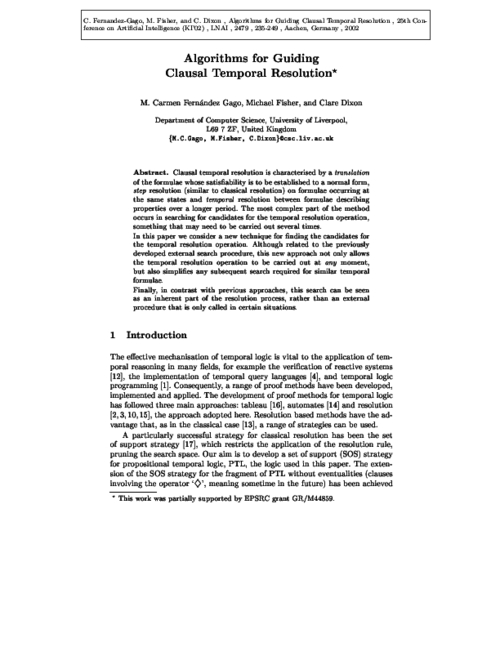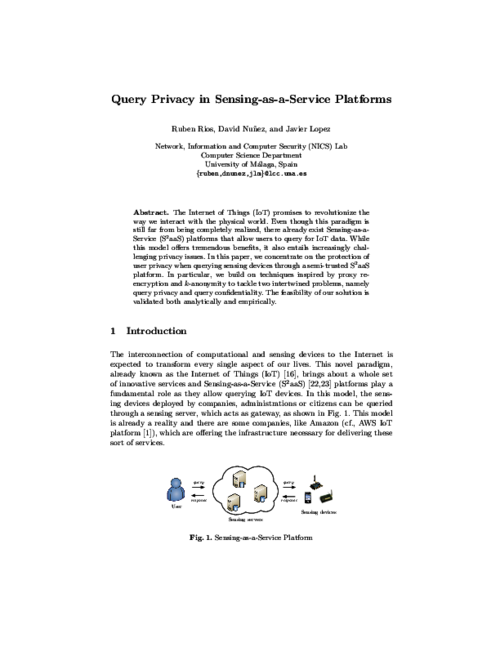 ] Type Year
] Type Year 25th Conference on Artificial Intelligence (KI’02), LNAI 2479, Springer, pp. 235-249, September, 2002.
Abstract
Clausal temporal resolution is characterised by a translation of the formulae whose satisfiability is to be established to a normal form, step resolution (similar to classical resolution) on formulae occurring at the same states and temporal resolution between formulae describing properties over a longer period. The most complex part of the method occurs in searching for candidates for the temporal resolution operation, something that may need to be carried out several times. In this paper we consider a new technique for finding the candidates for the temporal resolution operation. Although related to the previously developed external search procedure, this new approach not only allows the temporal resolution operation to be carried out at any moment, but also simplifies any subsequent search required for similar temporal formulae. Finally, in contrast with previous approaches, this search can be seen as an inherent part of the resolution process, rather than an external procedure that is only called in certain situations.} year = {2002

IEEE Systems Journal, vol. 13, issue 1, IEEE, pp. 238 - 247, 03/2019.
Digital Home Networking, R. Carbou, E. Exposito, R. Roman, and M. Diaz Eds., no. 7130, John Wiley & Sons Inc., pp. 60-96, 2011.
IX Jornadas de Ingeniería Telemática (JITEL’10), Y. Dimitriadis, and M. Jesús Ver Pérez Eds., pp. 237 - 244, Sept., 2010.
Abstract
Las aplicaciones basadas en localización proporcionan a los usuarios servicios personalizados dependiendo de su ubicación. Las estimaciones prevén que estos servicios se extenderán enormemente en los próximos años reportando grandes beneficios tanto a la industria como a los usuarios finales. Sin embargo, para que estos avances sean posibles se hace necesario analizar en profundidad las distintas implicaciones de seguridad y privacidad que la utilización de tales servicios pueden traer consigo a los usuarios. En este trabajo proponemos un sistema de localización que da soporte a la provisión de servicios basados en localización para entornos indoor y que se fundamenta en la tecnología de redes de sensores inalámbricos. En este esquema hemos tenido en cuenta diversos aspectos de seguridad y privacidad, prestando especial atención a la limitación extrema de recursos característica de las redes de sensores. Finalmente hemos desarrollado una prueba de concepto para comprobar la viabilidad de nuestro esquema dentro del ámbito del proyecto OSAmI.

32nd International Conference on ICT Systems Security and Privacy Protection (IFIP SEC 2017), S. De Capitan di Vimercati, and F. Martinelli Eds., IFIP Advances in Information and Communication Technology (AICT) 502, Springer, pp. 141–154, 05/2017. DOI
Abstract
The Internet of Things (IoT) promises to revolutionize the way we interact with the physical world. Even though this paradigm is still far from being completely realized, there already exist Sensing-as-a-Service (S2aaS) platforms that allow users to query for IoT data. While this model offers tremendous benefits, it also entails increasingly challenging privacy issues. In this paper, we concentrate on the protection of user privacy when querying sensing devices through a semi-trusted S2aaS platform. In particular, we build on techniques inspired by proxy re-encryption and k-anonymity to tackle two intertwined problems, namely query privacy and query confidentiality. The feasibility of our solution is validated both analytically and empirically.
